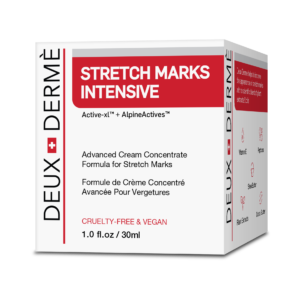If you’ve recently been struggling with weight gain, you may be concerned that your slowed metabolism will result in stretch marks. Conversely, you may also be worried about stretch marks if you’ve been struggling with obesity for a long time and are starting a new diet with plans to shed excess pounds as rapidly as possible.
There are three common causes of stretch marks associated with weight gain and weight loss:
- Gaining Weight: When the body expands rapidly due to weight gain, skin must stretch to compensate for the body’s growth. When skin stretches too far, it tears. The tearing of the dermis—or the middle layer of your skin—results in what we commonly refer to as stretch marks.
- Losing Weight: It makes sense that skin stretched too far due to weight gain can cause stretch marks, but how would weight loss also cause stretch marks? When losing weight, skin should be relaxing—not stretching. However, losing weight rapidly often results in excess skin, and excess skin can weigh down other areas of skin and cause stretching and tearing.
- Gaining and Losing Weight: Often, stretch marks develop when gaining weight but are not visible until the weight is lost. In this case, weight gain caused the stretch marks, but weight loss made the stretch marks visible on the body.
Stretch Mark Signs and Symptoms
There are typically no symptoms associated with stretch mark development, though some people report an itching sensation prior to stretch marks appearing. Stretch marks are recognizable immediately after appearing as dark purple lines that feel slightly indented.
Stretch marks due to either obesity or rapid weight loss can appear anywhere on the body but are commonly found on the stomach, arms, hips, thighs, and breasts.
Preventing Stretch Marks Due to Weight Gain or Loss
Unless you’re a bodybuilder or weightlifter, it’s unlikely that you are intentionally gaining weight. For this reason, it may seem like stretch marks are unpreventable. However, there are several lifestyle changes you can make at any time that can help prevent you from ever having to suffer from stretch marks:
- Avoid Rapid Change in Diets: Diets that significantly impact your daily intake of calories, such as low-carbohydrate diets, can cause you to lose weight rapidly. Rapid weight loss is more likely to result in excess skin and stretch mark development. It’s better to not experience rapid gain or loss too quickly by slowly integrating your new diet.
- Use a Stretch Mark Prevention Product Daily: A stretch mark prevention lotion or cream can drastically reduce your chances of developing stretch marks during periods of weight gain or loss. You can see a list of products we’ve compiled for prevention here.
- Work Some Cardio into Your Daily Routine: Getting regular exercise will increase your metabolism and decrease the likelihood that you’ll gain weight too rapidly.
- Avoid Excess Sugar Intake: Eating too much sugar will add a lot of calories to your daily food intake, but it can also damage your skin’s elasticity. Excess sugar can attach to the collagen in your body—a protein that promotes skin elasticity—and potentially damage it, possibly leaving skin brittle and more prone to tearing.
- Get the Proper Nutrition: A diet of high-fat foods can increase your likelihood of gaining weight and getting stretch marks. Planning meals of mostly lean proteins, green vegetables, and fruits will help ensure that you are getting the vitamins and minerals needed for healthy, flexible skin. Consult a doctor though about your specific nutrition.
Getting Rid of Stretch Marks
Unfortunately, stretch marks will not go away on their own. To fade significantly or disappear, they must be treated. Some common treatment methods are:
- Stretch Mark Removal Products: Many stretch mark removal products are available over the counter. These products are cost-effective and, when applied frequently, can be effective at reducing the appearance of or removing stretch mark discoloration.
- Chemical Peel: A chemical peel is the application of chemicals to the skin in order to cause skin damage and promote new skin growth. By promoting new skin growth over old stretch marks, stretch marks may become less visible and may even feel less indented. Keep in mind that multiple chemical peel treatments will be required to have the desired effects, so the process can be expensive and potentially take considerable time.
- Laser Treatment: Laser treatment entails damaging skin with a focused laser beam in order to promote skin regeneration in areas scarred by stretch marks. Though laser treatment can be effective in reducing the appearance, many treatments may be required before results are visible, and undergoing multiple treatment sessions can be costly. This stretch mark treatment cost calculator can be used to determine your likely costs of laser treatment.
Because weight gain and loss is not always controllable, a good rule of thumb for helping prevent stretch marks is to use a prevention product daily as a substitute for your general skin moisturizer.

